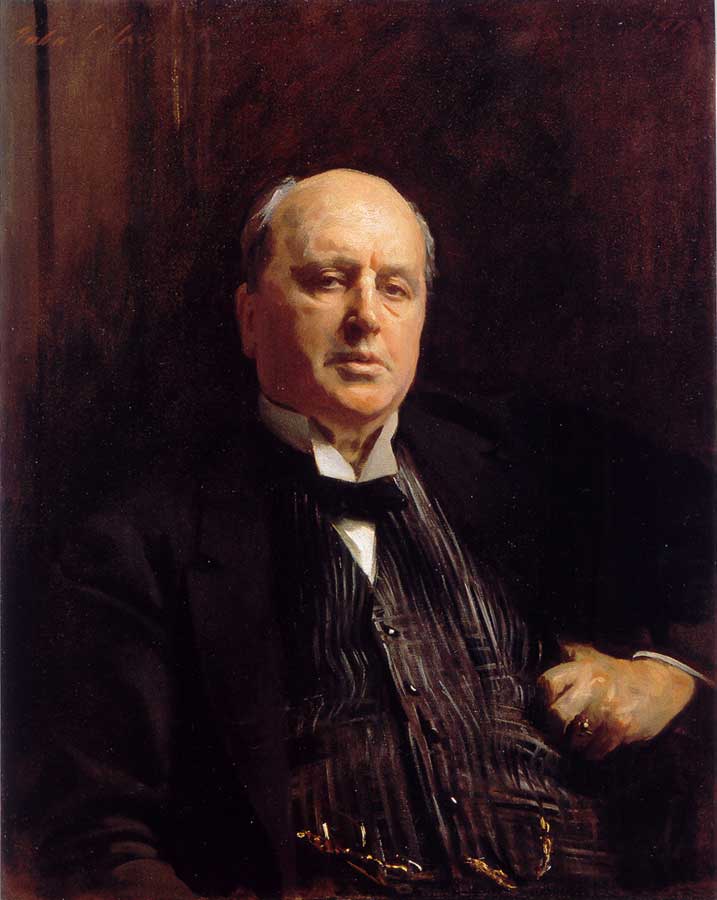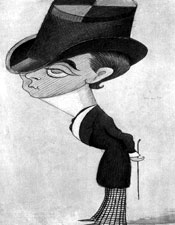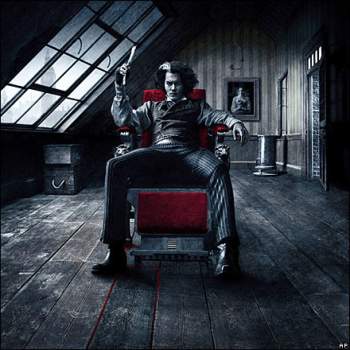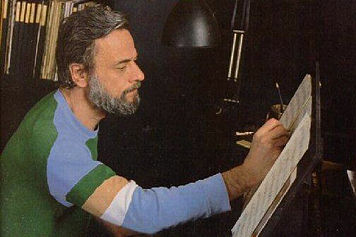5 x 5 Books … is a recommendation of five books that appears regularly in this space. Today’s installment comes from critic Michael Gorra. A professor of English at Smith College, Gorra is the editor of The Portable Conrad, out this month from Penguin. Earlier this year, he wrote about Henry James in Florence.
 You’ve read The Master and maybe Author, Author, you cottoned onto Diane Johnson’s Isabel in Le Divorce, might even have known that great old Beerbohm parody, “The Mote in the Middle Distance.” But James freaks can never quite get enough, and when we get done retelling our favorite anecdotes (most of them cribbed from Edith Wharton’s memoirs) we go looking for his figure in the carpet of other people’s work. We’re so apt to do it, in fact, that there’s even a book about it, Adeline Tintner’s Henry James Legacy: The Afterlife of his Figure and Fiction. Here are five places to find him.
You’ve read The Master and maybe Author, Author, you cottoned onto Diane Johnson’s Isabel in Le Divorce, might even have known that great old Beerbohm parody, “The Mote in the Middle Distance.” But James freaks can never quite get enough, and when we get done retelling our favorite anecdotes (most of them cribbed from Edith Wharton’s memoirs) we go looking for his figure in the carpet of other people’s work. We’re so apt to do it, in fact, that there’s even a book about it, Adeline Tintner’s Henry James Legacy: The Afterlife of his Figure and Fiction. Here are five places to find him.
1. “At The Grave of Henry James” by W.H. Auden. Actually I don’t much like this poem, which dates from just after the poet moved to America at the end of the 30s, that low dishonest decade. It has a creaky start, but it ends well, as it asks for forgiveness for the treason of all clerks; HJ was, at the time, famous as the writer who never served a cause outside his art. The grave itself is easy enough to find–he’s buried with the rest of his family in the Cambridge municipal cemetery, a slightly bedraggled cousin to the better-groomed Mt. Auburn. Auden saw it covered with snow, and my own first visit was on a bitter January day. I had a cold, and I was so hopped up, or maybe down, on antihistamines that I could hardly drive. But it was worth it.
2. The Ghost Writer by Philip Roth. The young Nathan Zuckerman sits up one night in the fifties reading “The Middle Years,” the tale of a dying writer who wishes he had a second chance to make his work come right. Roth must be on his third or fourth chance by now, so many revisionary selves has he put himself through. Or maybe its just Zuckerman. And James got that chance as well, in writing his prefaces and revising his work for the New York edition. What’s especially good about the Roth is the sense it gives of James’ importance to the self-conception of the mid-century American novelist, maybe especially his curious importance to Jewish writers.
3. “Lady Tal” by Vernon Lee. Vernon Lee–as everyone knows–is the pen-name of Violet Paget, an Anglo-Florentine and a childhood friend of John Singer Sargent. She wrote well about Italian art and also produced some genuinely creepy ghost stories. James liked her and admired the depth of her knowledge, but he never forgave her for turning him into a novelist called Jervase Marion–a name he might have used himself! The story is set in Venice, and other characters are recognizable as well. And while it is indeed catty it’s also highly readable, quite funny, and probably accurate in its portrait of his various hesitancies. Easiest to find now in Elaine Showalter’s anthology, Daughters of the Decadence.
4. Edith Wharton, passim. Which is exactly what one isn’t supposed to say these days, except that “Roman Fever” is the best analysis of “Daisy Miller” every written, and The Age of Innocence is all over The Portrait of a Lady. Not just because Wharton’s Newland and James’ Isabel share the same last name, but because Newland has memories of going dancing in Florence with a rather decayed group of expatriates–did the Countess Gemini try to hit on him? Also he’s a member of the Century Club, where if only he were real Newland would in 1875 have met a writer his own age, a young man giving New York one last try before heading off at last to Paris.
5. “Pandora” by–well, by HJ himself. Find this gem in the Library of America edition of his collected stories. A German diplomat comes to America, and on the ship over he both watches an American girl sashay along the deck, and reads a story about the misadventures of another such girl in Switzerland and Rome. Are the real girls like the ones in books, he wonders? Is “Daisy Miller” true? If you like this, you can then pick up W.D. Howells’ lovely Indian Summer, a book set in Italy in which the characters criticize each other for not coming up to the tone that reading James has made them expect. It’s a typically understated joke by the editor who bought The Portrait of a Lady for the Atlantic.
Archives for December 2007
TT: Almanac
 “Come to me in some grievous difficulty: I will talk to you like a father, even like a lawyer. I’ll be hanged if I haven’t a certain mellow wisdom. But if you are by way of weaving theories on some one who will luminously confirm or powerfully rend them, I must, with a hang-dog air, warn you that I am not your man. I suffer from a strong suspicion that things in general cannot be accounted for through any formula or set of formulae, and that any one philosophy, howsoever new, is no better than any other. This is in itself a sort of philosophy, and I suspect it accordingly; but it has for me the merit of being the only one that I can make head or tail of.”
“Come to me in some grievous difficulty: I will talk to you like a father, even like a lawyer. I’ll be hanged if I haven’t a certain mellow wisdom. But if you are by way of weaving theories on some one who will luminously confirm or powerfully rend them, I must, with a hang-dog air, warn you that I am not your man. I suffer from a strong suspicion that things in general cannot be accounted for through any formula or set of formulae, and that any one philosophy, howsoever new, is no better than any other. This is in itself a sort of philosophy, and I suspect it accordingly; but it has for me the merit of being the only one that I can make head or tail of.”
Max Beerbohm, “Laughter” (courtesy of Anecdotal Evidence)
TT: Back on the aisle
 Actually, I never left it–I merely shifted my reviewing activities elsewhere, and was more than glad to do so. But within hours of the settlement of the stagehands’ strike, three Broadway shows whose first nights had been temporarily scuttled were sending out press releases announcing that they would open their doors this week, just in time for me to work them into Friday’s drama column. Since I already had plenty of previously scheduled playgoing on my plate, not to mention a preview of the Sweeney Todd movie, this is what my appointment book looked like as of last Saturday morning:
Actually, I never left it–I merely shifted my reviewing activities elsewhere, and was more than glad to do so. But within hours of the settlement of the stagehands’ strike, three Broadway shows whose first nights had been temporarily scuttled were sending out press releases announcing that they would open their doors this week, just in time for me to work them into Friday’s drama column. Since I already had plenty of previously scheduled playgoing on my plate, not to mention a preview of the Sweeney Todd movie, this is what my appointment book looked like as of last Saturday morning:
• SATURDAY Wave goodbye to Mrs. T, who’s spending the first part of the week in Connecticut. Work on Louis Armstrong biography all afternoon. Meet The Rat for dinner, then take her to a preview of Lincoln Center Theater’s production of Cymbeline, directed by Mark Lamos.
• SUNDAY Two shows, West Bank, UK in the afternoon (accompanied by Lee Ann Westover of the Lascivious Biddies, who sang at my wedding) and Sweeney Todd in the evening (accompanied by Paul Moravec, who just finished writing the music for Scene 6 of The Letter). Go here for details.
• MONDAY Work on Armstrong all day, then head down to Broadway for the opening night of The Farnsworth Invention, Aaron Sorkin’s new play, accompanied by the friend who sent me this e-mail back in August.
• TUESDAY Write my “Sightings” column for the Saturday Journal, then return to Broadway for the opening night of August: Osage County, Tracy Letts’ new play, which is (gulp) three hours and twenty minutes long.
• WEDNESDAY Start writing Friday’s drama column. Tape a Commentary videoblog in the afternoon. Go to the Metropolitan Museum of Art to catch the first part of Chanticleer‘s annual Christmas concert, then rush over to Broadway for the final preview of The Seafarer, Conor McPherson’s new play.
• THURSDAY Finish and file drama column. Collect Mrs. T at the train station. No show tonight. Really.
 • FRIDAY Spend day working on the Armstrong biography and writing next week’s book column for the Commentary Web site, then escort Mrs. T to the Irish Repertory Theatre for a preview of their new production of George Bernard Shaw’s The Devil’s Disciple.
• FRIDAY Spend day working on the Armstrong biography and writing next week’s book column for the Commentary Web site, then escort Mrs. T to the Irish Repertory Theatre for a preview of their new production of George Bernard Shaw’s The Devil’s Disciple.
• SATURDAY To Milwaukee with Mrs. T, there to spend the weekend seeing all three installments of Milwaukee Rep‘s revival of Alan Ayckbourn‘s The Norman Conquests and (if possible) visiting the local art museum, which looks like…well, see for yourself.
• MONDAY Fly back to New York. Climb into a coffin of my native earth. Take the night off.
O.K., I know, it’s not exactly ditch-digging, but believe me, folks, that is hard work. And you’ll hear about all of it–sporadically. Intermittently. Occasionally. Mostly, though, I’ll be leaving the heavy lifting to CAAF and Our Girl, because this is One of Those Weeks.
Thank you, stagehands’ union. Thank you, League of Producers. I owe it all to you.
P.S. New Hot Fives and Out of the Past picks! Check ’em out.
TT: Almanac
“One half of the world cannot understand the pleasures of the other.”
Jane Austen, Emma
TT: Attend the tale
I just returned home from the third New York screening of Tim Burton’s film version of Stephen Sondheim’s Sweeney Todd, which opens four days before Christmas. The screening was held for the group that Chris Boneau, the publicist, referred to as “the Broadway community,” which includes drama critics (John Simon was sitting next to me). It was held at one of the big 42nd Street movie houses, and nearly every seat was full.
I brought along Paul Moravec, with whom I’m collaborating on The Letter. Needless to say, Paul isn’t exactly a member of the Broadway community, but he believes, like me, that Sweeney Todd is the great American opera. Moreover, it’s one of the works that inspired us to write The Letter. Mrs. T being in Connecticut for the week, I decided that Paul was an appropriate stand-in.
 Stephen Sondheim came to the theater to introduce the film, looking like a cat who’d just dined on canary under glass. “For those of you who know the show…forget it,” he said. “This is not a film of a musical, it’s a movie based on a musical.” Then the lights went down and the blood began to flow–or, rather, spurt.
Stephen Sondheim came to the theater to introduce the film, looking like a cat who’d just dined on canary under glass. “For those of you who know the show…forget it,” he said. “This is not a film of a musical, it’s a movie based on a musical.” Then the lights went down and the blood began to flow–or, rather, spurt.
As a member of the working press, I saw tonight’s screening under embargo, so I can’t say anything specific about Sweeney Todd until it opens in selected cities on December 21. (It opens wide on January 11.) What I can say is that it is–without exception, and by a considerable margin–the best film ever to have been made from a Broadway musical. The only other one to which it can possibly be compared is Bob Fosse’s 1972 screen version of Cabaret, and Sweeney is, aside from everything else, a better show. (It is, in my opinion, the best musical to have opened on Broadway since the end of World War II.) I also think it might actually do well at the box office, not to mention the next Oscar night.
Halfway throught he film, in the brief pause between “Epiphany” and “A Little Priest,” I leaned over to Paul and whispered, “This is the mark we have to hit.” He nodded.
On the street afterward, I said, “Inspiring, huh?”
Paul grinned. “The work waits…and I’m full of joy,” he replied. Then he disappeared into the night.
UPDATE: A friend writes:
Saying it’s the best film ever to be adapted from a Broadway musical feels like faint praise, since almost all these adaptations fail on the musical level (Chicago, One Touch of Venus), on the filmic level (My Fair Lady, West Side Story), or on just about every level (Mame, Phantom of the Opera).
True–as far as it goes. Alas, I can say no more!
CD
Van Cliburn, My Favorite Brahms. Middlebrow America’s favorite pianist got a bad rap from the critics, and on occasion he deserved it–but not this time. Cliburn’s 1973 collection of the solo-piano miniatures of Brahms is one of the outstanding piano recordings of the postwar era, a masterpiece of selection, execution, and interpretation. Nobody, not even Wilhelm Kempff, has played these broodingly autumnal cameos more sensitively or comprehendingly. The CD version contains five bonus tracks, all comparable in quality to the ones on the original LP (TT).
BOOK
The Portable F. Scott Fitzgerald. The number-one book on my super-short grab-in-case-of-evacuation list is this Viking Portable edition of Fitzgerald’s Greatest Hits, published in 1945 and, so far as I know, never reprinted. Dorothy Parker chose the selections and John O’Hara wrote the self-important but nonetheless oddly touching introduction: “He was elusive in life, God knows, and all through the writing of this piece he has refused to stay put, but the ectoplasm or the artist need not bother the reader or even me. For after all the stuff is here. The stuff is very much here, and it’s mellow.” The stuff in question is The Great Gatsby, Tender Is the Night, and nine of the very best short stories, all packed into a light but sturdy hardcover volume that will just about fit in the palm of your hand. More used copies are available here (TT).
DANCE
New York City Ballet, The Nutcracker (New York State Theater, Lincoln Center, closes Dec. 30). A half-century after it first knocked out New York audiences, George Balanchine’s verison of Tchaikovsky’s perennial family favorite remains the best of all possible Nutcrackers, above all for its letter-perfect opening scene, in which the greatest choreographer of the twentieth century put on stage the home-for-the-holidays Christmas of everybody’s dreams. It’s a permanent masterpiece of Western art–but don’t tell that to your kids (TT).
